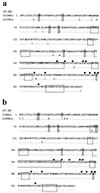Striking sequence similarity in inter- and intra-specific comparisons of class I SLG alleles from Brassica oleracea and Brassica campestris: implications for the evolution and recognition mechanism
- PMID: 9207151
- PMCID: PMC23881
- DOI: 10.1073/pnas.94.14.7673
Striking sequence similarity in inter- and intra-specific comparisons of class I SLG alleles from Brassica oleracea and Brassica campestris: implications for the evolution and recognition mechanism
Abstract
Self-incompatibility in Brassica is controlled by a single multi-allelic locus (S locus), which contains at least two highly polymorphic genes expressed in the stigma: an S glycoprotein gene (SLG) and an S receptor kinase gene (SRK). The putative ligand-binding domain of SRK exhibits high homology to the secretory protein SLG, and it is believed that SLG and SRK form an active receptor kinase complex with a self-pollen ligand, which leads to the rejection of self-pollen. Here, we report 31 novel SLG sequences of Brassica oleracea and Brassica campestris. Sequence comparisons of a large number of SLG alleles and SLG-related genes revealed the following points. (i) The striking sequence similarity observed in an inter-specific comparison (95.6% identity between SLG14 of B. oleracea and SLG25 of B. campestris in deduced amino acid sequence) suggests that SLG diversification predates speciation. (ii) A perfect match of the sequences in hypervariable regions, which are thought to determine S specificity in an intra-specific comparison (SLG8 and SLG46 of B. campestris) and the observation that the hypervariable regions of SLG and SRK of the same S haplotype were not necessarily highly similar suggests that SLG and SRK bind different sites of the pollen ligand and that they together determine S specificity. (iii) Comparison of the hypervariable regions of SLG alleles suggests that intragenic recombination, together with point mutations, has contributed to the generation of the high level of sequence variation in SLG alleles. Models for the evolution of SLG/SRK are presented.
Figures





References
-
- Thompson K F, Taylor J P. Heredity. 1966;21:345–362.
-
- Brace J, King G J, Ockendon D J. Sex Plant Reprod. 1994;7:203–208.
-
- Nou I S, Watanabe M, Isogai A, Hinata K. Sex Plant Reprod. 1993;6:79–86.
-
- Nasrallah J B, Nishio T, Nasrallah M E. Annu Rev Plant Physiol Plant Mol Biol. 1991;42:393–422.
Publication types
MeSH terms
Substances
Associated data
- Actions
- Actions
- Actions
- Actions
- Actions
- Actions
- Actions
- Actions
- Actions
- Actions
- Actions
- Actions
- Actions
- Actions
- Actions
- Actions
- Actions
- Actions
- Actions
- Actions
- Actions
- Actions
- Actions
- Actions
- Actions
- Actions
- Actions
- Actions
- Actions
- Actions
LinkOut - more resources
Full Text Sources
Other Literature Sources
Research Materials

